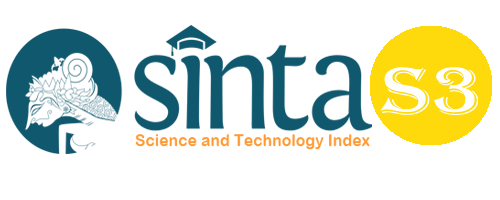Analysis of Village and Poverty Funds in Indonesia
Abstract
The purpose of the study through a statistical model of ratio, growth and moving average found that the use of village funds in Indonesia during the 2015-2020 period was an average of IDR 38 (trillion rupiah) with the highest growth rate of village funds in 2016 of 124.78%, the budget which is not in line with the percentage of poverty in Indonesia of 3.41% or 17,280,000 (people). The lowest growth in village funds was in 2018 at 0.16% and not in line with the decline in poverty in Indonesia at 3.42% or at 25,670,000 (people). The village fund for a month is Rp. 134,876 assuming 4 members and the ratio of village funds to poverty is Rp.539, 504 or people's income is classified as low. UThe highest village fund budget occurred in 2018 of Rp. 50 (trillion rupiah) in the same year poverty increased in Indonesia to 27,293,333 (people) or 11.13%. The results of the moving average model found a value of 3.10%, meaning that ifAssuming there is an increase in the poverty rate by 3.43%, then the village fund becomes Rp.472.595 or is in a position above the poverty line.To overcome the problem of poverty is to increase the ratio of village fund budgets to the number of poor people and implement productive empowerment programs that have implications for increasing community income and involving village community participation.
Keywords
Full Text:
PDFReferences
Angelia, N. et al. (2020). Analysis of Community Institution Empowerment as a Village Government Partner in the Participative Development Process. Budapest International Research and Critics Institute-Journal (BIRCI-Journal). P. 1352-1359.
Agustina, N. W., & Handayani, S. (2017). “Kemampuan Keluarga dalam Merawat Pasien Skizofrenia dengan Gejala Halusinasi”. Urecol, 439-444.
Alifudin, M. R., & Ediati, A. (2019). “Pengalaman Menjadi Caregiver: Studi Fenomenologis Deskriptif Pada Istri Penderita Stroke”. Jurnal Empati, Vol. 8 (1).
Darwin, P., Hadisukanto, G., Elvira, S.D. (2013). “Beban Perawatan dan Ekspresi Emosi pada Pramurawat Pasien Skizofrenia”. Indon Med Assoc, Volume 63, Nomor 2.
Fadli, S. M., & Mitra, M. (2013). “Pengetahuan dan Ekspresi Emosi Keluarga serta Frekuensi Kekambuhan Penderita Skizofrenia”. Kesmas: National Public Health Journal, Vol. 7 No. 10.
Fitrikasari, A., Kadarman, S.A., Woroasih S., & Sarjana W. (2012). “Gambaran Beban Caregiver Penderita Skizofrenia di Rawat Jalan RSJ Amino Gondhohutomo Semarang.” Medica Hospitalia, Vol. 1 No. 2.
Fontaine, K.L. (2009). Mental Health Nursing. 6th Ed. New Jersey: Pearson Prentice Hall
Friedman, M.M., Bowden, V.R., & Jones, E.G. (2010). Buku Ajar Keperawatan Keluarga: Riset, Teori, dan Praktek. Jakarta: EGC.
Kementrian Kesehatan. (2019). Profil Kesehatan Republik Indonesia Tahun 2018. Kementerian Kesehatan RI. Jakarta.
Nenobais, A., Jatimi, A. and Jufriyanto, M. (2019) ‘Family Burden for the Caregivers of People with Mental Disorders: A Systematic Review’, Jurnal Ners, 14(3), p. 26. Doi: 10.20473/jn.v14i3.16971.
Pangandaheng, N.D. (2018). “Pengalaman Keluarga Merawat Klien Dengan Gangguan Jiwa”. Doctoral Dissertation, Universitas Airlangga Surabaya.
Ralevic, S. et al. (2015) ‘Faktori rizika za razvoj opterećenja negovatelja osoba sa mentalnim poremećajima’, Medicinski Casopis, 49(3), pp. 89–94. Doi: 10.5937/mckg49-9410.
Rinawati, F. and Sucipto, S. (2017) ‘Pengaruh Beban Terhadap Stres yang Dialami Keluarga Dalam Merawat Pasien Gangguan Jiwa’, Jurnal Ilmu Kesehatan, 6(1), p. 22. Doi: 10.32831/jik.v6i1.150.
Sapouna, V. et al. (2015) ‘Exploring the burden of the family caregivers of patients with major mental disorders in Greece’, Review of Clinical Pharmacology and Pharmacokinetics, International Edition, 29(1), pp. 25–35.
Setiawan V.B, dan Wulandari R.D. (2016). “Beban Kerja Subjektif dan Obyektif Tenaga Farmasi Rawat Jalan di Rumah Sakit”. Jurnal Adm Kesehatan Indonesia. Volume 4 No. 1.
Sitepu, F. et al. (2020). Differences in Depression Based on Stigma among Caregiver Female of People with Schizophrenia. Budapest International Research and Critics Institute-Journal (BIRCI-Journal). P. 2629-2637.
Stuart, G.W. (2013). Principles and Practice of Psychiatric Nursing. 10th Ed. Canada: Evolve
Rukmini, Candra T. & M. Syafiq. (2019). “Resiliensi pada Keluarga Sebagai Caregiver Pasien Skizofrenia dengan Kekambuhan”. Character: Jurnal Penelitian Psikologi, Volume 06 Nomor 02.
Widyastuti, H.R. (2011). “Gambaran Beban Keluarga Dalam Merawat Lansia Dengan Demensia di Kelurahan Pancoranmas, Depok, Jawa Barat: Studi Fenomenologi.” Jurnal Kesehatan, Volume 1 No. 7.
Von Kardorff, E. et al. (2016) ‘Family caregiver burden in mental illnesses: The case of affective disorders and schizophrenia - A qualitative exploratory study’, Nordic Journal of Psychiatry, 70(4), pp. 248–254. Doi: 10.3109/08039488.2015.1084372.
DOI: https://doi.org/10.33258/birci.v5i1.3597
Article Metrics
Abstract view : 110 timesPDF - 51 times
Refbacks
- There are currently no refbacks.

This work is licensed under a Creative Commons Attribution-ShareAlike 4.0 International License.

This work is licensed under a Creative Commons Attribution-ShareAlike 4.0 International License.

_.gif)

















_.gif)



